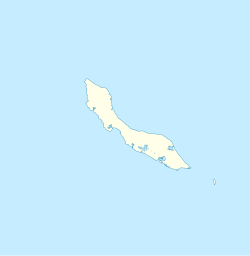Kurá Hulanda Museum is an anthropological museum in Curaçao. The museum specialises in the Atlantic slave trade, and opened in April 1999.
 Big mama statue by Hortence Brouwn in front of the museum | |
| Established | April 1999 |
|---|---|
| Location | Klipstraat 9, Otrobanda, Willemstad, Curaçao |
| Coordinates | 12°06′29″N 68°56′08″W / 12.10801°N 68.93562°W |
| Website | kurahulanda.com |
History
editThe Kurá Hulanda Museum was an initiative of Jacob Gelt Dekker. In the late 1990s, he was approached by the Government of Curaçao to develop the western quayside in Otrobanda where the slave ships arrived with slaves to be sold at the nearby slave market. Dekker decided to buy the derelict buildings on the quay and market, restore the buildings to their original condition, and open a museum at the site specialising in the Atlantic slave trade.[1]
The museum opened in April 1999.[2] It consists of 15 buildings,[2] displaying the history from the capture in Africa to the relocation in the Americas. It also displays the cultural heritage of the slaves on the culture of Curaçao in particular and the Caribbean in general.[3]
Hotel
editDekker bought most of the buildings on the hillside,[1] and opened the luxury Kurá Hulanda Hotel & Lodge next to the museum. The hotel was declared bankrupt in October 2013.[4] In November 2013, the hotel was sold to GHL Hotels, a Colombian hotel chain.[5]
References
edit- ^ a b Adrian Mourby (23 October 2011). "Freedom at last, after centuries of Dutch rule". The Independent. Retrieved 19 April 2021.
- ^ a b "Museum". Kura Hulanda. Archived from the original on 2 April 2015. Retrieved 19 April 2021.
- ^ "Kura Hulanda Museum". Curacao.com. Retrieved 19 April 2021.
- ^ "Kurá Hulanda Curaçao failliet". Curacao 365 (in Dutch). Retrieved 19 April 2021.
- ^ "Kurá Hulanda Curaçao van (voorheen) Jacob Gelt Dekker maakt doorstart". Quote (in Dutch). Retrieved 19 April 2021.
External links
edit- Official site
- Media related to Kura Hulanda museum at Wikimedia Commons
